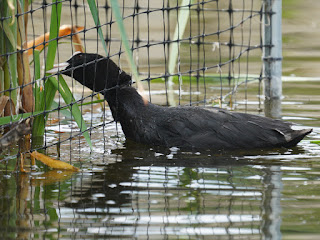The reed bed by the bridge has a family of Reed Warblers in it, I think with three young. This is a surprise, as there hasn't been much song from a male here and he has mostly been heard in the other small reed beds in the Long Water. They young are moving around and may have come from a nest elsewhere.
The noisy Wren at the leaf yard had a moment of peace when the Carrion Crows were away, and sang from time to time.
Young Great Tits have a charmingly gormless look.
So, on a much larger scale, do young Grey Herons. I think this is one from the second nest on the island, which they are still using though their parents are no longer feeding them and they are having to find their own fish.
The little island in the Long Water was deserted by Mute Swans, Egyptian Geese and Coots, leaving a heron to use it as a fishing platform. The mess of droppings from all its inhabitants will soon weather down and become soil for plants from seeds brought by birds.
More Cormorants have arrived on the lake to feed on this year's young fish. Two preened on the posts at the island.
The Great Crested Grebe chick at the bridge could be heard begging incessantly between the noise of passing cars while waiting for its other parent to bring a fish. The two were just dawdling, so they were swimming with one foot.
This is the grebe chick from the middle of the Long Water. It's odd that all four pairs of grebes on the lake have just one chick each, when the supply of small fish seems to be abundant.
A Coot in the Italian Garden chewed through an iris leaf to bring to its mate ...
... which was sitting under a natural arbour of purple loosestrife.
The watchful parents of the ten Greylag goslings saw a dog approaching in the distance and called their brood to attention, ready to run to the lake. But the dog was separated by two fences and is on a lead, so the alarm subsided.
Two Canada x Greylag hybrid geese passed on their way to the Lido, which is closed while new showers are put in so that it has become a place of rest again.
Only one Mallard duckling was left at Peter Pan.
A patch of anemones near the bridge was full of Buff-Tailed Bumblebees ...
... while a patch of campanulas next to it had numerous Honeybees. They do seem to stick to one kind of flower. This is explainable for Honeybees anyway, since if a worker bee finds a good source she will report it to the hive and attract more bees to the spot.
The first Fairy Ring mushrooms are beginning to come up in the grass.













It's surprising how much facial expression differs in young and adult birds. Young herons, great tits and gulls have an innocent and harmless look, but look at their adult counterparts!
ReplyDeleteAlways funny seeing Grebes idly paddling with just one foot.
I suppose we're anthropomorphising about facial expressions, though it's hard not to. I think you could say that Little Owls really do have facial expressions done mostly with their big white eyebrows, but even here we're probably misreading them.
DeleteLovely photo of the Reed Warbler & pleased they have a successful family there. The small reedbeds in our local country park have also been rather furtive this year.
ReplyDeleteI think that small reed beds have less singing because there's only one male in each and no competition. The larger reed bed by the Diana fountain has three males and was full of constant song for months.
Delete